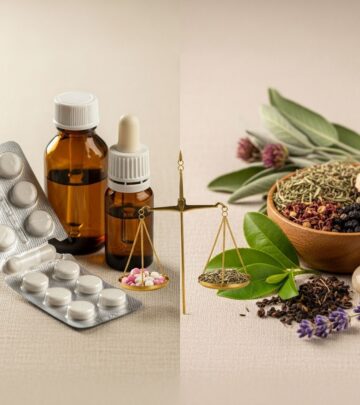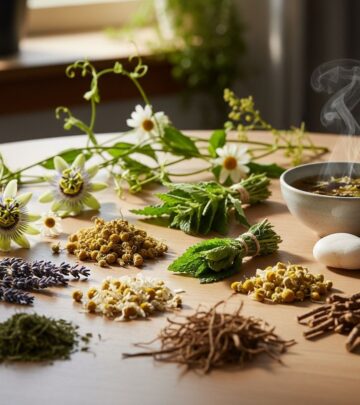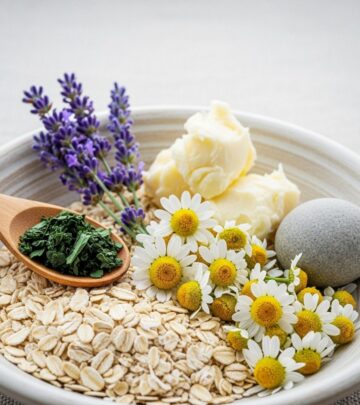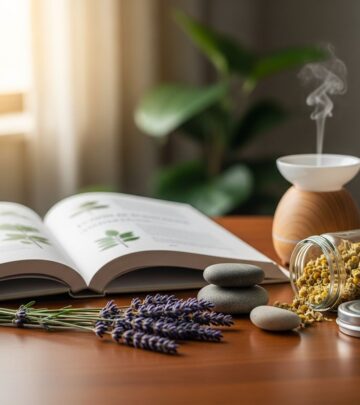Herbs That Heal: Natural Remedies for Good Health
Unlock the transformative power of over 100 healing herbs, with practical guidance for natural wellness and holistic living.

Herbs That Heal is a comprehensive exploration of the remarkable healing powers of nature’s pharmacy. Drawing from centuries-old traditions and modern research, this guide unveils the therapeutic potential of over 100 herbs, offering actionable advice for healing, prevention, and holistic well-being.
The Magic of Herbs
Herbs are renowned for their almost magical effects on health. Their properties are vast, often acting rapidly and gently to relieve many common complaints:
- Spasms may relax and muscle pain may decrease.
- Digestive disturbances, such as constipation, can be overcome.
- Nervousness and headaches fade under gentle herbal action.
- Colds, allergies, and fevers are soothed.
- Natural compounds can even arrest minor bleeding and manage minor wounds and bruising.
Herbs work with the body’s own wisdom, often with fewer side effects than synthetic drugs, restoring balance and vitality while gently addressing symptoms and underlying causes.
The Heritage of Herbal Healing
Healing with plants dates back to the first humans; archaeological evidence shows early Neanderthals used herbs for food and healing. Across ages and cultures, herbal knowledge has been handed down through generations:
- Traditional herbal practices arose independently in China, India (Ayurveda), the Middle East (Unani), and Europe.
- Remedies—like camomile for digestion or ginger for nausea—are still universally used in similar ways around the globe today.
- Despite the growth of modern medicine, herbalism remains foundational in primary health care for millions.
Herbs are integral to folk medicine, traditional healing, and holistic health, bridging ancient wisdom and contemporary science.
The Proof: Science Meets Tradition
Modern pharmaceutical research owes much to traditional herbal remedies. Many vital drugs have their origins in plant compounds discovered and used by herbalists:
- Aspirin was derived from willow bark, used for centuries as a pain reliever.
- Tranquilizers, heart-saving digitalis (foxglove), and household names like chywanprash have herbal roots.
- Countless tonics, balms, and medicines in modern pharmacopoeia trace their efficacy to the active ingredients of plants.
This synergy between scientific validation and traditional use establishes herbal medicine as a credible, effective approach to many health concerns.
Herbs Covered: An Overview
The guide details more than one hundred herbs, most of which are easily available, including many common kitchen spices and garden plants. Each herb entry typically covers:
- Botanical name and common names
- Parts of the plant used (leaves, roots, seeds, bark, etc.)
- Medicinal properties and active compounds
- How the herb assists in preventing or curing specific ailments
- Preparation and usage—infusions, decoctions, powders, tinctures, poultices, and more
- Safety notes and contraindications where applicable
Organization of the Book
The book is organized into two main sections, systematically arranged for ease of use:
- The first section presents 66 primary herbs with significant healing properties—each in detail, including origin, chemistry, health benefits, and detailed preparation notes.
- The second section offers concise descriptions of 41 supplementary herbs of milder potency but noteworthy health value.
Herbs are typically listed alphabetically by their English or widely recognized trade names, ensuring quick reference for both lay users and practitioners.
Sample Table: Key Details for Selected Herbs
| Herb | Main Uses | Part Used | Notable Compounds |
|---|---|---|---|
| Basil (Tulsi) | Respiratory issues, fever, skin problems | Leaves | Eugenol, flavonoids |
| Chamomile | Digestive aid, calming nerves, sleep | Flowers | Apigenin, bisabolol |
| Ginger | Nausea, inflammation, circulation | Rhizome | Gingerol, shogaol |
| Fenugreek | Diabetes, digestive disorders, lactation | Seeds | Saponins, fiber, 4-hydroxyisoleucine |
| Turmeric | Anti-inflammatory, arthritis, wounds | Rhizome | Curcumin |
Remedies for Common Ailments
The book offers an index of ailments—a helpful tool for readers to find herbal solutions to specific health issues. Some examples include:
- Coughs and colds: Basil, ginger, licorice, and eucalyptus act as natural cough relievers and decongestants.
- Digestive upsets: Chamomile, peppermint, cumin, and fennel help soothe the digestive tract and relieve gas or bloating.
- Stress and insomnia: Valerian, ashwagandha, and chamomile calm the nerves and promote restful sleep.
- Inflammatory pain: Turmeric, ginger, and boswellia provide natural anti-inflammatory benefits.
- Skin problems: Aloe vera, neem, and calendula can be applied or consumed for various skin ailments.
Each remedy includes practical instructions for preparation and use: herbal teas, topical pastes, tinctures, and oils.
Preparing and Using Herbal Remedies
The effectiveness of herbal medicine depends on correct preparation and usage. The guide details several standard methods:
- Infusions: Steeping leaves or flowers in hot water, ideal for delicate plant parts.
- Decoctions: Simmering tougher materials (roots, bark) to extract active compounds.
- Powders and capsules: Finely ground herbs, sometimes taken with water or in food.
- Tinctures: Alcohol-based extractions, highly concentrated and long-lasting.
- Poultices and compresses: Direct application of herbal material to skin for wounds and inflammation.
Proper dosage, duration, and combination with diet or conventional therapy are emphasized for safety and optimal results.
Integration with Modern Health Practices
The book does not position herbal healing as a replacement for modern medicine. Instead, it encourages a balanced, integrative approach:
- Herbs can complement mainstream treatments, supporting general health and reducing side effects.
- Lifestyle choices—such as nutrition, exercise, and stress management—are vital for achieving lasting health.
- Readers are encouraged to consult healthcare providers, especially in the case of chronic illness or when using herbs alongside prescribed drugs.
Author’s Background and Contribution
H.K. Bakhru is a respected authority in naturopathy and herbal medicine, known for deeply researched, accessible, and practical guidance. With a long career in writing and teaching:
- He has written bestsellers including Foods That Heal, Vitamins That Heal, and Natural Home Remedies for Common Ailments.
- Bakhru has received awards such as the Lifetime Achievement Award from the Indian Board of Alternative Medicines.
- He has actively promoted natural healing and continues charitable efforts through his personal foundation.
His expertise is informed by traditional wisdom, modern science, and decades of practical experience.
Why Herbal Remedies Matter Today
In a world of rising chronic illness, environmental stress, and drug side effects, herbal remedies offer:
- Accessibility: Most herbs are inexpensive and widely available.
- Safety: When used appropriately, herbs can provide healing with fewer risks.
- Holistic support: Herbs often address the whole person—body, mind, and spirit—not just isolated symptoms.
- Cultural resonance: Herbal medicine remains vital in many world traditions and cultural practices.
Frequently Asked Questions About Healing Herbs
Q: Are herbs safe for everyone?
A: Most common culinary and garden herbs are safe when used as directed, but some can interact with medications or be unsuitable for people with allergies, pregnant women, or children. Always check trusted resources and consult a professional for advice if in doubt.
Q: How long does it take to notice the effects of herbal remedies?
A: Unlike pharmaceuticals, herbs often work gently and gradually, promoting long-term balance. Mild conditions may improve within days, while chronic issues may require consistent use for weeks or months.
Q: Can herbal remedies replace prescription medications?
A: Herbal remedies should be seen as complementary to, not replacements for, prescribed treatment. In some cases, they can reduce drug side effects or support healing, but do not self-medicate for serious illnesses without consulting a healthcare provider.
Q: What are the best ways to store medicinal herbs?
A: Keep dried herbs in airtight containers, away from heat, light, and moisture. Use within 1 year for best potency. Fresh herbs can be refrigerated or dried for longer use.
Q: How can I learn to identify herbs safely?
A: Always begin with reputable guides or courses in herbal identification, ideally guided by local experts. Misidentification can lead to dangerous misuse; many toxic plants resemble medicinal ones.
Conclusion
Herbs That Heal is a trustworthy, insightful resource for harnessing the natural powers of herbs. Through centuries of wisdom and contemporary evidence, it offers realistic, practical strategies for improving health and vitality through the gentle support of plants. With detailed instructions, safety guidance, and an integrated approach, this book empowers readers to embark on a journey of natural wellness.
References
- https://www.orientpublishing.com/books/health-and-fitness/herbs-that-heal
- https://www.exoticindiaart.com/book/details/herbs-that-heal-natural-remedies-for-good-health-idf015/
- https://sunshinebookseller.com/product/herbs-that-heal-natural-remedies-for-good-health/
- https://books.google.com/books/about/Herbs_that_Heal.html?id=C0D3z66O8Q8C
- https://books.apple.com/us/book/herbs-that-heal/id1514922061
- https://www.goodreads.com/book/show/54757918-herbs-that-heal
- https://www.abebooks.co.uk/9788122201338/Herbs-Heal-Natural-Remedies-Good-8122201334/plp
Read full bio of Sneha Tete












